ISSN ONLINE(2319-8753)PRINT(2347-6710)
ISSN ONLINE(2319-8753)PRINT(2347-6710)
| Musa Alhassan, Igor L. Boiko Department of Geotechnics and Environmental Engineering, Belarusian National Technical University, Minsk, Belarus |
| Related article at Pubmed, Scholar Google |
Visit for more related articles at International Journal of Innovative Research in Science, Engineering and Technology
The paper presents results of experimental and theoreticalevaluation of load bearing capacity of shallow foundations with different vertical cross-sectional shapes. Load-settlement relationships ofmodels of shallow foundations with rectangular, wedge and T shape vertical cross-sections were studied through experimentation, and theoretically using Terzaghi bearing capacity equation.The experimental and theoretical evaluations show the load bearing capacity increasing in the order: T shape > wedge shape >rectangular shape. The study indicate that the soil above the bases of shallow foundations with wedge and T vertical cross-sectional shapes, function not only as surcharge to the soil below the bases (as is the case of rectangular shape), but also offers additional resistance to structural loads, and thereby increasing the load bearing capacity of the foundations. The economicbenefit of using wedge and T shapes shallow foundations is also demonstrated
Keywords |
| Foundation shape; Load bearing capacity; Settlement; Soil base. |
INTRODUCTION |
| Load bearing capacity of foundationis a function of its dimension and shape, its embedment depth, physico-mechanical properties of the soil base and load geometry. Foundations are generally classified into shallow foundations and deep foundations. Shallow foundations are those types of foundations that transmit structural loads to the soil strata at a relatively small depth. Terzaghi [1] defines shallow foundation as that which is laid at a depth Df not exceeding the width B of the foundation, that is Df/B≤1. However, other research studies have shown thatDf/B can be as large as 3 to 4 for shallow foundations [2-4]. |
| It is a conventional believes that in orderto increase the load bearing capacity of shallow foundation and reduce stresses on the soil base, the base area (width) is increased.Many studies conducted over the years, on scale effect of shallow foundation on load bearing capacity, have shown that increase base width of shallow foundation does not necessarily (always) translate to increase in the load bearing capacity [5-13]. |
| Shallow foundations of various types/shapes are known, with strip, square, rectangular and circular shapes being the most widely used. These conventionaltypes of shallow foundations have different shapes which only vary from each other plan-wise or by horizontal cross-section. Theirvertical cross-sectional shapes(depending on the design thickness) arebasically the same. This makes the mode of their interaction with the soil bases vertically, basically the same. Moststudies on the interaction of foundations with soil bases are carried out using load-settlement approach. Many studies[14-18], havebeen conducted on the effect of foundation shape on settlement and load bearing capacity of soils.Vast of these past studies considered the shape of the foundations plan-wise. The interaction of these shapes of foundations with the soil bases is such that the soil above their bases contributes to the resistance of the structural loads mostly by surcharging the soil below the base of the foundation.Therefore the study of other shallow foundations shapes, which can both partly distribute/resist structural loads vertically along their trunks and bases, is presented. V and T-shape foundations were considered along with the conventional rectangular shape foundations. The study presents of load-settlement relationship of soil under foundations with these shapes. This study is anchored on the fact that, it is commonly believed that the settlement (deformation) criterion is more critical than the bearing capacity one in the designs of shallow foundations [19]. Generally the settlements of shallow foundations such as pad or strip footings are limited to 25 mm [20]. Studies on (especially small scale) shallow foundations have suggested that ultimate bearing capacity can be estimated at settlement of 10% of foundation width [7, 8]. |
MATERIALS AND METHODS |
| Three wooden models of shallow foundationswere used for the study: the first model was a rectangular shaped block with dimension of 30x60x60 mm for width, length and height respectively; the second model was a wedge-shaped block of 60 mm height with width and length for top and lower sides as 60x60 mm and 30x60 mm respectively; and the third was a Tshape block of 60 mm height with width and length for top and lower parts as 60x60 mm and 30x60 mm respectively (fig. 1). The dimensions of the models were chosen so as to be within Df/B≤2 (Dfand B are depth of foundation embedment and width respectively). |
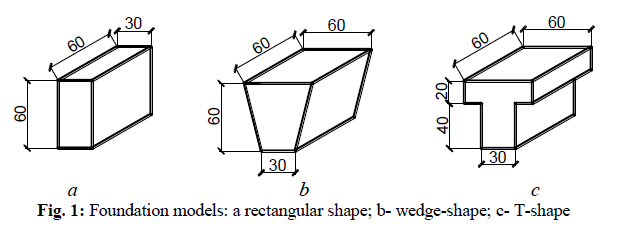 |
| Three subsoil conditions were modeled in a rectangular container with dimension 1100ÃâÃâ¦600ÃâÃâ¦250 mmforlength, height and width respectively. One of the soil conditions was modeled using sand, while the other two were modeled using clay soils. |
| In modeling the first soil condition, medium and coarse grained sands were compacted in layers of 25 and 50 mm, with each layer compacted to unit weight of 19 kN/m3 and 18 kN/m3 at moisture contents of 6 % and 8 % for medium and coarse grained sand respectively (fig. 3). The 19 kN/m3 medium grained sand was compacted to 60 mm layer thickness on the 18 kN/m3coarse grained sand as shown in fig. 2. |
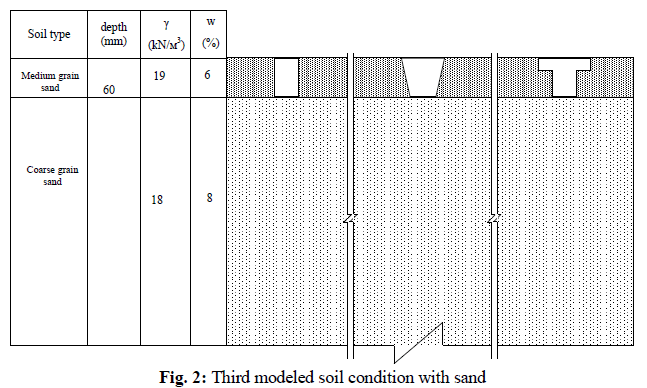 |
| In modeling the second and third soil conditions, the experimental stand was filled with the soils in layers of 25 and 50 mm, with each layer compacted to unit weight of 18 kN/m3 and 17 kN/m3 at moisture contents of 10 % and 20 % for stiff and soft soil respectively as shown in figs. 3-4. In the case of the second soil condition, clay soil with moisture content of 10 % wascompacted to unit weight of 18 kN/m3into the whole test tank, as shown in fig.3. |
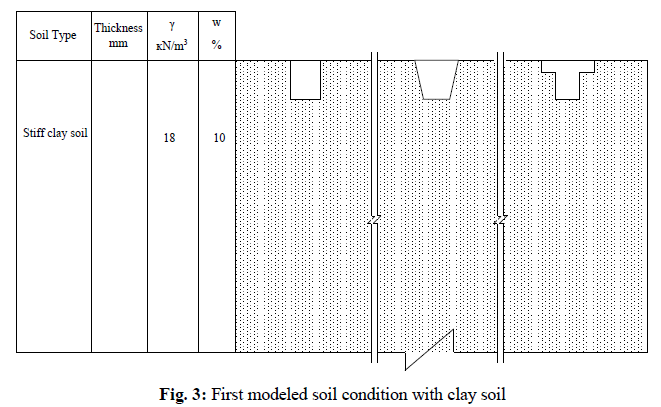 |
| In modeling the third soil condition, the stiff clay soil of 10 %moisture content, was compacted to unit weight of 18 kN/m3, up to 60 mm below the top of the test tank. The remaining 60 mm depth was then filled with the soft clay soil ot 20 % moisture content and17kN/m3unit weight, as shown in fig. 4. |
| The foundation models were placed during placement and compaction of the last two upper layers as shown in figs. 2- 4. Using 1:10 loading lever, loads were vertically, centrally and uniaxially applied to the foundations in an incremental manner, recording corresponding settlement for each load increment, using dial gauges of 1/100 mm division. Subsequent load increments were done when the rate of settlement from the previous loads becomes less than 0.02 mm/min. |
| The results are presented graphically as load-settlement curves for the respective foundations under respective modeled soil conditions in figs 5-7. |
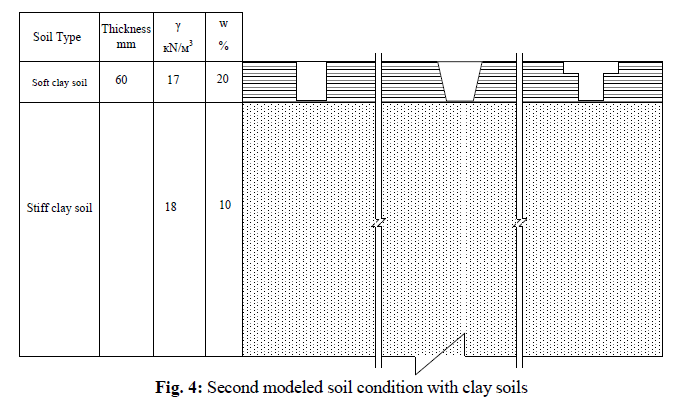 |
EXPERIMENTAL RESULTS AND DISCUSSION |
| From the figures, it is observed that the load bearingcapacity of T shape foundation is generally higher than those of rectangular and wedge shapes. The lowest load bearing capacity was observed with rectangular shape. The relatively higher load bearing capacity recorded with T and wedge shapes is attributed to additional resistance offered by the soil above their bases from the compression by their flanges. |
| From fig. 5, it is observed that for rectangular shape foundation, the load-settlement curve is linear up to 0.5 kN load, after which the settlement begins rapid increase with subsequent load increments. But for wedge and T shape foundations,rapid increase in settlement with subsequent load applications begin after 0.62 kN load. This observation is attributed to additional resistance offered by the soil above the bases of T and wedge shapes from the compression by their flanges. Note that the difference in the patterns of the curves becomes more defined after these defined loads. |
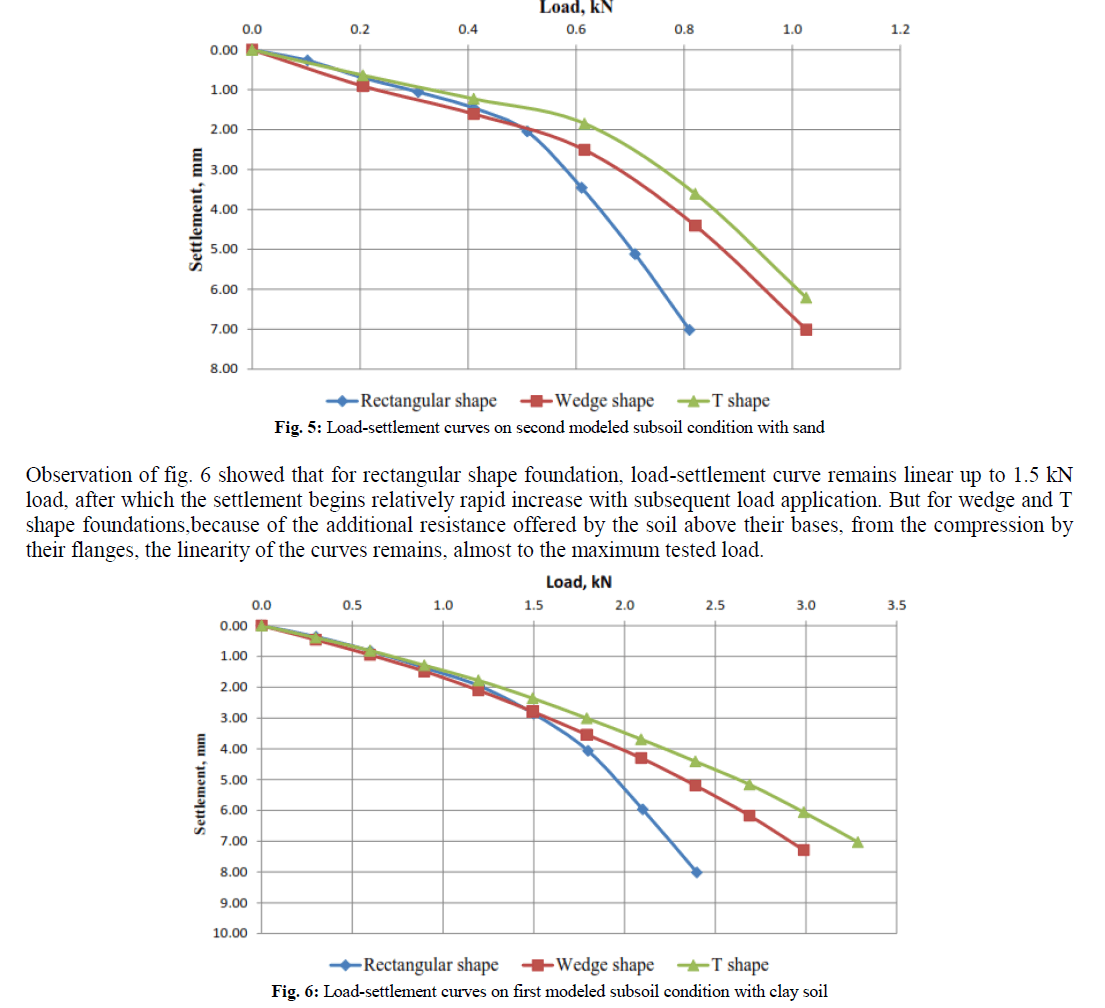 |
| Observation of results on the first (fig. 5, base of sand) and second (fig. 6, base of clay soil) modeled soil conditions, shows that, higher load bearings, in relation to settlement were generally recorded with all the foundations shapes on the second condition as compared to those recorded on the first condition. The cohesive nature of the clay soils, which enable full mobilization of the shear strength parameters (c and φ) was responsible for the observed trend on the second condition, in comparison with the first. The relatively lower loads bearing recorded on the first condition is as a result of the mobilization for load resistance from frictional component only. |
| Observation of fig. 7 shows the load-settlement curves of the three shapes taking relatively similar pattern. This can be explained by the presence of the soft soil layer above the bases of the foundations, which offers not much resistance to the flanges of wedge and T shapes. This resulted in much of the resistance been offered by the stiff soil beneath the base of the foundations, and hence the pattern of the curves. |
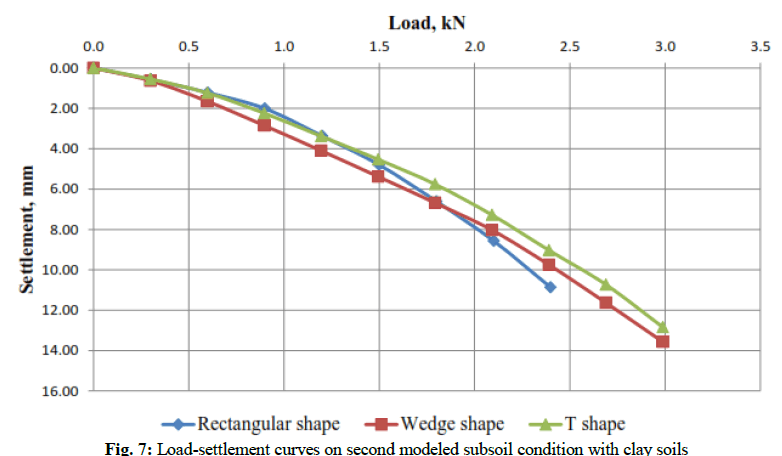 |
THEORETICAL EVALUATION USING TERZAGHI BEARING CAPACITY EQUATION |
| In order to theoretically evaluate the load bearing capacity of foundation with wedge and T vertical cross-sectional shapes, Terzaghi general bearing capacity equation for load bearing resistance at the base of foundation of rectangular stripe foundation, for two layered soil, was used, |
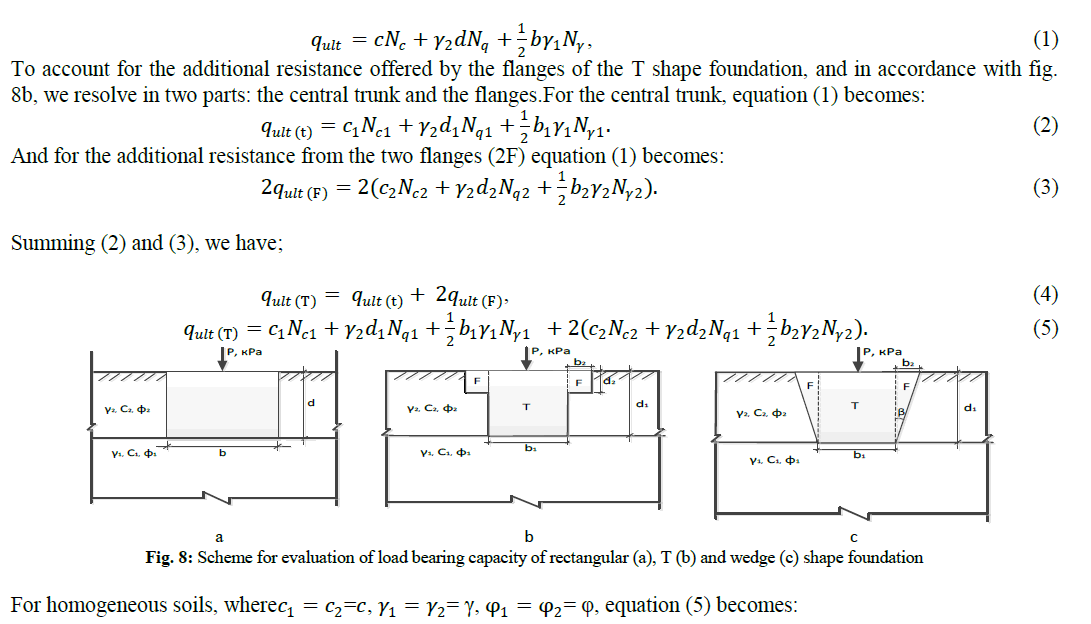 |
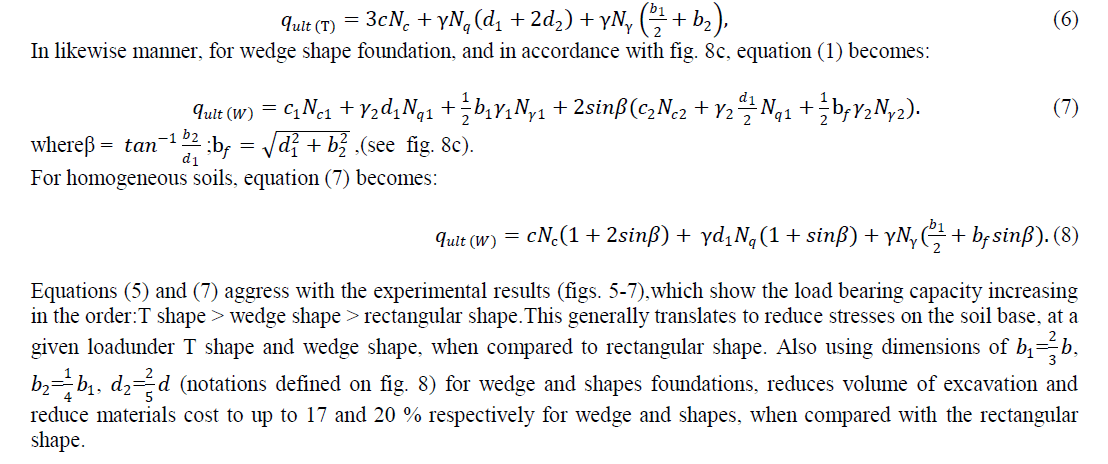 |
CONCLUSION |
| The study shows that bulk of the load resistance of subsoil bases of shallow foundations with rectangular vertical crosssectional shapes is mostly offered by the soil beneath the foundation base, while for those with wedge and T-shape vertical cross-sectional shape, additional resistance is also offered by soil along their vertical stems, which generally translate to increase in load bearing capacity of the foundations. The experimental and theoretical evaluations show the load bearing capacity increasing in the order: T shape > wedge shape > rectangular shape. The economics of using wedge and T shapes shallow foundations is also demonstrated. |
References |
|